Zygomorphy and heterandry in Solanum in a phylogenetic context
Zygomorphy and heterandry in Solanum in a phylogenetic context
Zygomorphy and heterandry in Solanum in a phylogenetic context
You also want an ePaper? Increase the reach of your titles
YUMPU automatically turns print PDFs into web optimized ePapers that Google loves.
gra<strong>in</strong>s <strong>and</strong> seed surface features to determ<strong>in</strong>e whether the heterantherous <strong>Solanum</strong> species<br />
form a natural group, exam<strong>in</strong>ed biogeographic patterns among the heterantherous<br />
solanums, <strong>and</strong> attempted to identify the sister groups to the heterantherous taxa. The work<br />
reported here focuses on the same key species groups identified <strong>in</strong> Lester et al. (1999) <strong>and</strong><br />
builds on this foundation by analyz<strong>in</strong>g most of these species <strong>in</strong> a <strong>phylogenetic</strong> framework<br />
us<strong>in</strong>g DNA sequence data. Our results are compared to those of Lester et al. (1999) <strong>and</strong> <strong>in</strong><br />
some cases extend beyond their paper to suggest well supported sister relationships<br />
between heterantherous <strong>and</strong> isantherous <strong>Solanum</strong> species. We also evaluate the<br />
biogeographic patterns of the heterantherous species <strong>in</strong> a <strong>phylogenetic</strong> <strong>context</strong> <strong>and</strong><br />
suggest further morphological <strong>and</strong> molecular studies that will elucidate evolutionary <strong>and</strong><br />
developmental patterns <strong>in</strong> these taxa.<br />
TAXA STUDIED<br />
With<strong>in</strong> <strong>Solanum</strong>, several groups exhibit strik<strong>in</strong>g degrees of heteranthery, often<br />
accompanied by other floral modifications such as zygomorphy <strong>and</strong> enantiostyly. Lester<br />
et al. (1999) focused on four <strong>Solanum</strong> groups that show strong heteranthery: 1) the<br />
Normania group, 2) the Androceras group, 3) the Anisantherum <strong>and</strong> Monodolichopus<br />
group, <strong>and</strong> 4) the Nycterium group. In our study, we <strong>in</strong>cluded representatives of as many<br />
of these groups as possible, along with isantherous species hypothesized to be their<br />
closest relatives. We also <strong>in</strong>cluded S. thelopodium, a member of the S. thelopodium<br />
species group of Knapp (2000). Flowers <strong>in</strong> this group are highly heterantherous but these<br />
species were not exam<strong>in</strong>ed by Lester et al. (1999). Floral morphologies, breed<strong>in</strong>g systems<br />
(here def<strong>in</strong>ed as the presence of self-compatibility vs. self-<strong>in</strong>compatibility), <strong>and</strong> previous<br />
ideas of relationships are summarized below <strong>and</strong> <strong>in</strong> Table 1 for the five focal groups.<br />
Illustrations of representative flowers of heterantherous <strong>Solanum</strong> species <strong>and</strong> their<br />
relatives are given <strong>in</strong> Figs. 2 <strong>and</strong> 3.<br />
Focal Groups <strong>in</strong> the Non-Sp<strong>in</strong>y <strong>Solanum</strong>s<br />
1. <strong>Solanum</strong> thelopodium Species Group. This group <strong>in</strong>cludes three non-sp<strong>in</strong>y species of<br />
South American primary ra<strong>in</strong>forest shrubs. These species were neglected until Knapp’s<br />
recent treatment, <strong>in</strong> which two of the three species were newly described (Knapp, 2000).<br />
Although these taxa are obviously closely related, they have not been properly placed <strong>in</strong><br />
any of the published <strong>Solanum</strong> sections (see Knapp, 2000 for a summary of the taxonomic<br />
<strong>and</strong> nomenclatural history of the group). The flowers are five-merous with act<strong>in</strong>omorphic<br />
corollas. The <strong>and</strong>roecium is highly heterantherous with a unique comb<strong>in</strong>ation of stamen<br />
morphologies (Fig. 2A). The lowermost stamen is longest due to its very long anther <strong>and</strong><br />
filament. The uppermost stamens are shortest <strong>and</strong> the middle two stamens are<br />
<strong>in</strong>termediate <strong>in</strong> length, with the length difference due ma<strong>in</strong>ly to differences <strong>in</strong> filament<br />
length (Knapp, 2000). The style is straight <strong>and</strong> extends through the groove between the<br />
anther thecae of the longest <strong>and</strong> lowermost stamen. There is no evidence of<br />
<strong>and</strong>romonoecy <strong>in</strong> this group, <strong>and</strong> breed<strong>in</strong>g systems of the three species are unknown.<br />
2. Normania Clade. This monophyletic group encompasses three species formerly placed<br />
<strong>in</strong> the genera Normania <strong>and</strong> Triguera. All were re<strong>in</strong>stated <strong>in</strong> or transferred to <strong>Solanum</strong> by<br />
Bohs <strong>and</strong> Olmstead (2001) when they were found to form a clade nested with<strong>in</strong> the genus.<br />
<strong>Solanum</strong> trisectum <strong>and</strong> S. nava Webb & Berthel. (former members of genus Normania)<br />
are native to Macaronesia, whereas S. herculeum (former genus Triguera) is found <strong>in</strong><br />
nearby areas of Spa<strong>in</strong> <strong>and</strong> northwestern Africa. All are five-merous, with act<strong>in</strong>omorphic<br />
to slightly zygomorphic corollas <strong>and</strong> unusual floral morphologies, but the flowers of<br />
S. herculeum are quite different from those of the other two species. In this species, the<br />
anthers are equal or subequal <strong>and</strong> each is tipped by two small apical horns (Fig. 2E). They<br />
dehisce <strong>in</strong>itially by two subapical pores that enlarge <strong>in</strong>to longitud<strong>in</strong>al slits with age.<br />
Breed<strong>in</strong>g systems <strong>and</strong> poll<strong>in</strong>ation biology have not been <strong>in</strong>vestigated <strong>in</strong> this species.<br />
In contrast, the <strong>and</strong>roecium of <strong>Solanum</strong> trisectum <strong>and</strong> S. nava is highly<br />
heterantherous, with two long curved anthers, two medium-sized curved anthers, <strong>and</strong> one<br />
short relatively straight anther (Fig. 2D). The shortest stamen is lowermost <strong>in</strong> the flower,<br />
202
















